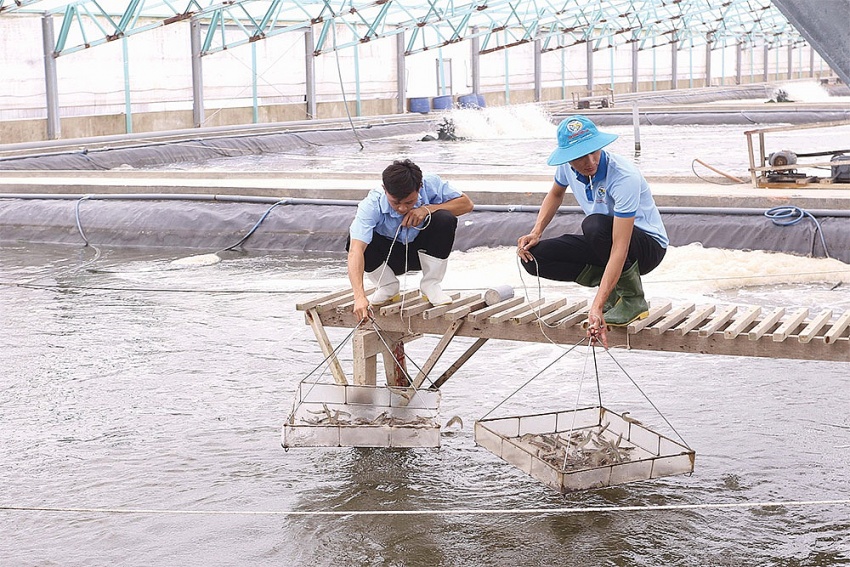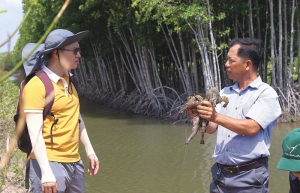Advances in tech aid shrimp output
According to data from the General Department of Vietnam Customs, shrimp export turnover in the first three months of this year is estimated to have reached more than $620 million, up almost one-quarter over the same period last year. In the two main export markets of the United States and China, the proportion of shrimp exports recorded growth of 26 per cent and 140 per cent, respectively.
 |
| Advances in tech aid shrimp output, photo Le Toan |
Ta Thi Kim Thu, a market expert at the Vietnam Association of Seafood Exporters and Producers (VASEP), said that the demand for shrimp imports in key markets is still quite high.
“Compared to some of the main shrimp suppliers to the US market such as India, Ecuador, and China, Vietnam is considered more promising, especially when diplomatic relations between the two countries are very good,” said Thu.
VASEP earlier in the year predicted that the potential of exporting shrimp to the US would be affected after the American Shrimp Processors Association proposed anti-subsidy taxes on imported shrimp and increasing sea freight rates. However, since the US Federal Reserve gave optimistic signals about the general economic picture, the consumption trend of Americans has rapidly improved.
Meanwhile, China is also increasing shrimp imports from Vietnam after restricting imports from Ecuador due to the content of sodium metabisulfite, a preservative commonly used in the food industry to prevent oxidation higher than allowed levels.
VASEP added that demand for shrimp imports from the Japanese market is also expected to recover soon. “Vietnamese shrimp is leading the market share of high-end shrimp in Japan,” she said. “Japanese consumers demand high-quality products, consistent with Vietnam’s processing level and capacity.”
According to Trinh Trung Phi, deputy general director of Aquaculture Technical at Viet Uc Seafood Corporation, despite being among the top countries in shrimp export, Vietnam’s shrimp industry is facing many barriers.
“The cost of shrimp food is increasing, leading to an increase in production costs. Vietnam’s whiteleg shrimp costs per one kilogramme is about $4, while the figure is only $3 in India, and $2.5 in Ecuador. The next challenge comes from not being proactive about quality breeds. More than 80 per cent of the current source of broodstock shrimp depends mainly on imported sources and wild exploitation,” Phi said.
Viet Uc is currently the top enterprise in the shrimp seed segment in Vietnam, accounting for more than 30 per cent of market share. It is also the first and only enterprise to cooperate exclusively with the CSIRO Institute, the largest scientific and industrial research agency in Australia, to develop a genetics and breeding programme for shrimp broodstock in Vietnam.
Not only does it spend plenty of resources on investing in quality seed research, Viet Uc also invests heavily in shrimp farming and processing technology with three high-tech commercial shrimp farming and production complexes, moving forward to close the value chain.
Over the past five years, the company has invested more than $62.5 million to develop membrane shrimp farming, successfully changing the perspective of sustainable shrimp farming without using antibiotics, and reducing the rate of destruction during the farming process from 30 per cent to zero.
Minh Phu Seafood Corporation has researched and raised shrimp using MPBiO biotechnology to reduce product costs, while still ensuring quality,
Minh Phu is currently the largest shrimp exporter in Vietnam, with more than 99 per cent of shrimp sold each year for export. The group aims to increase its domestic market share by 5-10 per cent by bringing shrimp lines that meet Japanese, American, and European export standards, are raised in an antibiotic-free and chemical-free environment, and are distributed in the Bach Hoa Xanh system to provide domestic consumers with a source of high-quality shrimp.
Ho Quoc Luc, chairman of the Board of Directors of Sao Ta Food JSC, said that global customers evaluate Vietnamese shrimp as having excellent quality, but the price can be too high.
“This is a repeat of the previous competitive path of Indonesian shrimp, but now, Indonesian shrimp prices have become softer. Vietnam’s shrimp industry must have solutions to improve processing levels and diversify products to attract consumers and maintain high-level market share,” Luc said.
Vietnamese shrimp has been exported to about 100 countries and territories. Vietnam is also continuously in the top three countries exporting the most shrimp worldwide, with export value accounting for 13-14 per cent of the total global shrimp export value. Every year, the shrimp industry contributes about 40-45 per cent of total seafood export value, according to VASEP.
 | Shrimp farms adapt to modern techniques Natural shrimp breeding in mangroves are being replicated in the Mekong Delta, becoming exemplary models of economic development. |
What the stars mean:
★ Poor ★ ★ Promising ★★★ Good ★★★★ Very good ★★★★★ Exceptional
Related Contents
Latest News
More News
- Mondelez Kinh Do - a chapter of purpose-led leadership in Vietnam (December 18, 2025 | 09:44)
- VNPAY services receive the highest-level PCI DSS international security certificates for six consecutive years (December 17, 2025 | 23:47)
- PPL extends its reach into ASEAN (December 17, 2025 | 15:44)
- Over 600 BUV graduates meeting quality benchmarks across triple quality assurance levels (December 17, 2025 | 13:00)
- HEINEKEN Vietnam partners with Ho Chi Minh City Traffic Police on road safety drive (December 17, 2025 | 09:42)
- BUV and China’s CSCSE sign MoU to boost educational cooperation (December 17, 2025 | 08:00)
- PVT Logistics honoured with ‘Fast Enterprise Award’ at APEA 2025 (December 16, 2025 | 18:22)
- Empowering Sustainable Data Centers with Smart Infrastructure Solutions (December 16, 2025 | 13:59)
- Vietjet wins gold ESG transport sustainability award in Taiwan (China) (December 13, 2025 | 22:03)
- Legal framework completed for national digital transformation (December 13, 2025 | 21:55)

 Tag:
Tag:






















 Mobile Version
Mobile Version